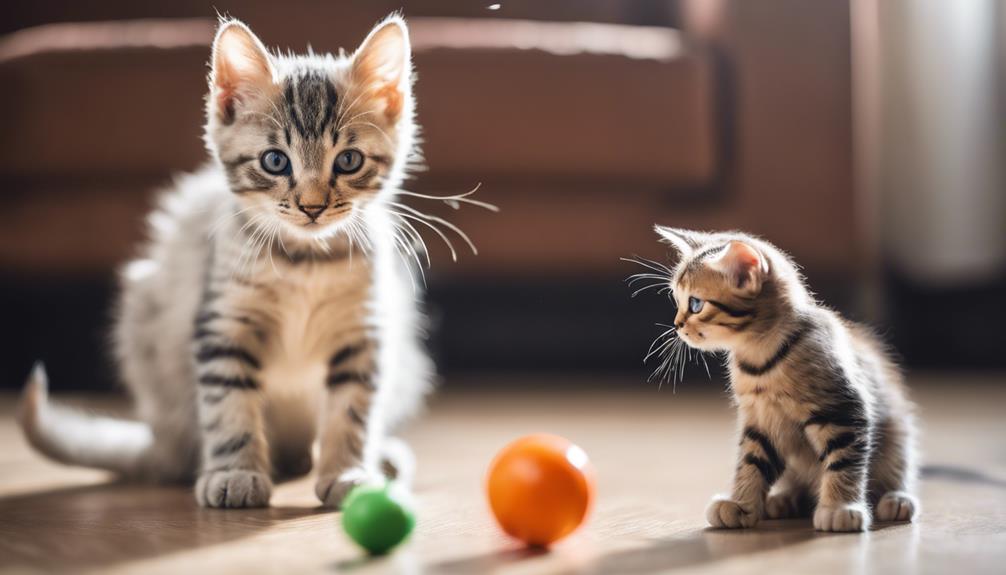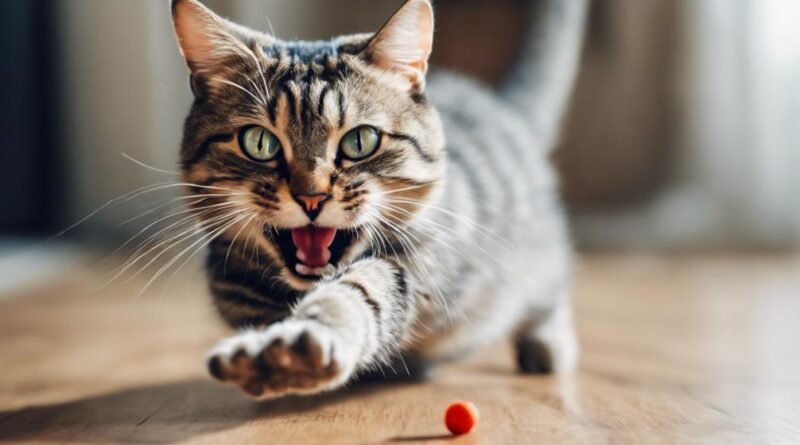9 Psychological Factors Influencing Cat Play Behavior
Imagine your feline friend's playful antics – have you ever wondered what drives their behavior?
From ancient instincts to individual preferences, understanding the psychological factors influencing cat play can shed light on your pet's behavior.
By considering these factors, you may unravel the mystery behind why your cat pounces, stalks, and engages in playful activities.
Innate Instincts
When observing cat play behavior, it becomes evident that innate instincts heavily influence their actions. Cats are driven by instinctual drives that stem from their natural behaviors. These instincts are deeply ingrained in their nature and play a significant role in how they interact with their environment and engage in play activities.
One of the most prominent instinctual drives in cats is their hunting instinct. This primal urge to hunt is a fundamental aspect of a cat's natural behavior. Even in domestic settings, cats exhibit behaviors such as stalking, pouncing, and chasing, reminiscent of their wild ancestors. When engaging in play, you may notice your cat displaying hunting behaviors, like swatting at feathers or chasing after a toy mouse. These actions not only provide physical exercise but also fulfill their instinctual need to hunt.
Additionally, territorial instincts play a crucial role in cat play behavior. Cats are territorial animals by nature, and play serves as a way for them to establish and maintain their territories. You may observe your cat engaging in playful behaviors like scratching or marking objects with their scent glands. Through play, cats are able to assert their presence and mark their territories, fulfilling their innate drive to establish boundaries.
Social Interaction
Social bonds play a vital role in shaping cat play behavior, influencing their interactions with both feline companions and humans. Cats are social animals that engage in play to establish and maintain relationships with others. Understanding the role of social interaction in cat play can provide insights into their behavior and relationships. Here are some key points to consider:
- Play dynamics: Cats use play as a way to strengthen social bonds with their fellow felines and human companions. Through play, cats can establish hierarchies, resolve conflicts, and build trust within their social groups.
- Social bonding: Play serves as a tool for cats to communicate and connect with others on an emotional level. Engaging in play activities helps cats form strong social bonds with their playmates, leading to healthier and more fulfilling relationships.
- Communication cues: Cats use various communication cues during play to convey their intentions and emotions to their play partners. Understanding these cues, such as tail movements, ear positions, and vocalizations, is essential for interpreting cat play behavior accurately.
- Bonding behaviors: Certain behaviors exhibited during play, such as grooming, mutual grooming, and shared resting, are essential for strengthening social bonds among cats. These bonding behaviors help foster a sense of camaraderie and companionship within the social group.
Environmental Influence
The environment significantly shapes and influences a cat's play behavior, affecting their interactions and overall well-being. Cats are highly responsive to their surroundings, and environmental factors play a crucial role in determining their play patterns. Providing an enriching environment is essential for promoting healthy play behaviors in your feline companion.
When considering play therapy for your cat, it's important to create a stimulating environment that encourages natural behaviors. Cats are instinctual hunters, and incorporating interactive toys that mimic prey can engage their natural instincts and provide mental and physical stimulation. By setting up a play area with scratching posts, climbing structures, and puzzle toys, you can create an environment that promotes active play and mental enrichment.
Cats exhibit a stimulus-response behavior when it comes to play. The environment can act as a trigger for play behaviors, influencing how a cat engages with toys and interacts with their surroundings. By observing your cat's responses to different stimuli, such as toys, sounds, and movements, you can tailor their play environment to cater to their preferences and encourage healthy play habits.
Stress and Anxiety
Stress and anxiety can greatly impact a cat's play behavior, influencing their interactions and overall well-being. Cats, like humans, can experience stress due to various factors in their environment. Here are some key points to consider regarding stress and anxiety in cats:
- Physical Manifestations: Cats may display signs of stress through behaviors like excessive grooming, hiding, or changes in appetite. These manifestations can also influence how they engage in play.
- Impact on Playfulness: When a cat is stressed or anxious, they may show a decreased interest in play or exhibit more aggressive behaviors during play sessions. Understanding these cues is crucial for maintaining a positive play environment.
- Stress Relief: Providing outlets for stress relief, such as interactive toys, scratching posts, or calming environments, can help alleviate anxiety and encourage healthier play behaviors.
- Coping Mechanisms: Just like humans, cats can benefit from coping mechanisms like regular play sessions, environmental enrichment, and positive reinforcement. These strategies can help reduce stress levels and promote a more playful demeanor.
Predatory Behavior
Experiencing stress and anxiety can trigger predatory behavior in cats, influencing how they engage in play and interact with their environment. When cats exhibit predatory behavior, they often display hunting patterns that mimic their natural hunting instincts. This behavior is deeply ingrained in their nature, stemming from their ancestral roots as wild hunters.
Cats may demonstrate predatory behavior during play by stalking, pouncing, and chasing after toys or objects that resemble prey. This instinctual behavior is driven by their innate need to hunt and capture food. When stressed or anxious, cats may rely on these behaviors as a way to release pent-up energy and alleviate tension.
Understanding your cat's predatory behavior can help you provide appropriate outlets for their natural instincts. Engaging them in interactive play sessions with toys that stimulate their hunting instincts can be beneficial. By allowing them to exhibit these behaviors in a controlled environment, you can help satisfy their need for physical and mental stimulation.
Observing your cat's hunting patterns can also provide valuable insight into their behavior and preferences. Some cats may prefer toys that resemble small prey animals, while others may enjoy toys that move quickly to simulate a chase. By catering to your cat's natural hunting instincts, you can strengthen your bond and enhance their overall well-being.
Play as Learning
Engaging in play serves as a valuable tool for cats to learn and develop essential skills. Cats, like humans, benefit greatly from learning through play. Here are some key aspects of how play contributes to feline cognitive development:
- Problem-Solving Skills: Play allows cats to practice problem-solving in a safe and enjoyable environment. Whether it's figuring out how to catch a moving toy or strategizing during interactive play sessions, cats enhance their cognitive abilities through these challenges.
- Social Development: Play provides opportunities for cats to interact with other animals or humans, helping them improve their social skills. Through play, cats learn about social cues, boundaries, and communication, which are crucial for their overall development.
- Physical Coordination: Playful activities such as chasing toys or climbing scratching posts help cats improve their physical coordination and agility. These movements not only keep them physically fit but also enhance their motor skills.
- Stress Reduction: Play serves as a form of stress relief for cats, allowing them to release pent-up energy and anxiety. Engaging in play helps cats relax, promoting mental well-being and cognitive function.
Age and Development

In the early stages of life, cats undergo significant physical and cognitive development that profoundly influences their play behavior. Kittens display rapid growth in their cognitive abilities, which impacts their play styles. As kittens mature, their play behavior becomes more sophisticated, incorporating stalking, pouncing, and wrestling, mirroring hunting behaviors seen in the wild.
Behavioral changes also play a crucial role in how cats engage in play. Younger cats tend to have bursts of energy and play frequently throughout the day as they explore their environment and develop their physical coordination. As cats age, their play frequency may decrease, but the intensity of their play sessions often increases.
During their development, cats go through various stages that shape their play preferences and styles. For example, younger cats may engage in more solitary play, while older cats might prefer interactive play with their human companions. Understanding these age-related changes can help cat owners provide appropriate outlets for play at every stage of their pet's life.
Individual Preferences
Understanding the unique preferences of your cat is essential for fostering a fulfilling play experience for both you and your feline companion. Cats, like humans, have individual preferences when it comes to play styles and toy choices. By paying attention to what your cat enjoys, you can enhance the bond you share and ensure that playtime is engaging and beneficial for your furry friend.
- Play Styles
Cats vary in their preferred play styles. Some may enjoy chasing and pouncing on toys, while others might prefer stalking and ambushing their playthings. Understanding your cat's play style can help you tailor the play experience to best suit their needs.
- Toy Preferences
Just as with play styles, cats also have specific toy preferences. Some cats may be drawn to toys that mimic prey, such as feather wands or toy mice. Others might prefer interactive toys that engage their hunting instincts. Observing which toys capture your cat's interest can guide you in selecting the most engaging options.
Frequently Asked Questions
Can Cat Play Behavior Be Influenced by the Presence of Other Pets in the Household?
If you have other pets at home, their presence can definitely influence your cat's play behavior. Pet dynamics play a crucial role in how your feline friend interacts during playtime. Social interactions with other animals can impact the way your cat engages in play, whether they become more energetic or more reserved.
It's important to observe and understand how your pets interact to ensure they've positive and enjoyable play experiences together.
How Does a Cat's Previous Experiences With Play Affect Their Behavior in Adulthood?
When it comes to how your cat's past play experiences shape their behavior as adults, it's all about early interactions. Kitten socialization and play therapy are crucial for a well-rounded cat.
Engaging in enrichment activities and providing a stimulating environment can positively impact their play behavior later in life.
Are There Any Differences in Play Behavior Between Indoor and Outdoor Cats?
When comparing indoor and outdoor cats' play behavior, there are notable differences due to socialization and environmental enrichment. Indoor cats may engage more in interactive play with their human companions, while outdoor cats might exhibit more predatory behaviors in their play.
Providing environmental enrichment like toys and climbing structures can help both types of cats stay mentally and physically stimulated. These factors can influence how indoor and outdoor cats approach and enjoy playtime differently.
Can a Cat's Play Behavior Change in Response to Changes in Their Environment, Such as Moving to a New Home?
When you move to a new home, your cat's play behavior might change due to environmental changes and stress. These adjustments can impact their social dynamics and affect how they engage in play.
Keep an eye on your cat's behavior during the transition and provide them with familiar toys and spaces to help them feel more comfortable.
Are There Any Specific Ways to Address or Manage Play-Related Behavioral Issues in Cats?
To address play-related behavioral issues in cats, consider play therapy and behavior modification. Engage your feline friend with interactive toys and enrichment activities. These can help channel their energy positively and provide mental stimulation.
Conclusion
In conclusion, understanding the psychological factors influencing cat play behavior can help you create a stimulating and enriching environment for your feline friend.
By considering their innate instincts, social interaction needs, environmental influences, and more, you can better cater to their play preferences and overall well-being.
Paying attention to these factors will ensure a happy and healthy relationship with your beloved pet.
